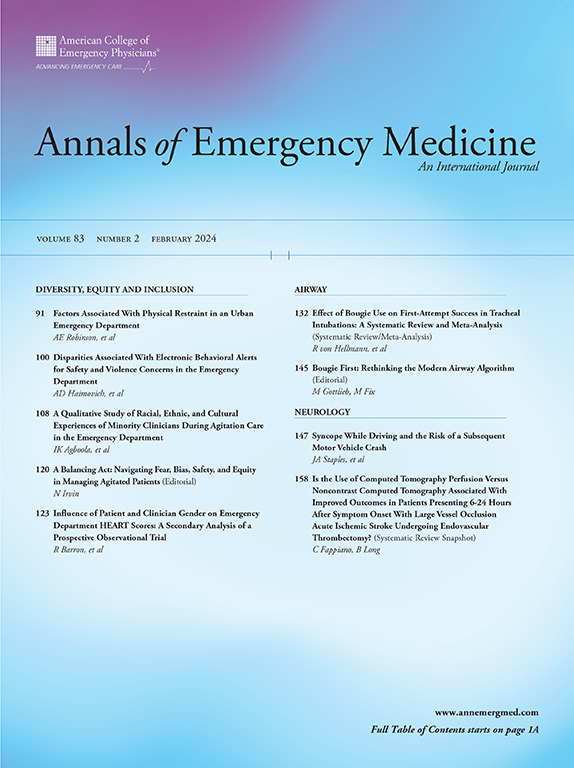2016年至2023年非研究行业对急诊医生的支付趋势
IF 5
1区 医学
Q1 EMERGENCY MEDICINE
引用次数: 0
摘要
研究目的表征2016年至2023年间美国急诊医生非研究行业支付的流行程度、价值和性质。方法:这是对开放支付数据的重复横断面分析,该数据由医疗保险和医疗补助服务中心每年发布,从2016年到2023年。我们调查了非研究行业支付给急诊医生的费用。主要结果是急诊医生每年接受行业付款的比例。次要结局是支付总额、支付规律以及按形式、性质和相关药品的支付分布。我们用描述性统计来总结趋势。结果2016-2023年研究期间,共有27,970/80,270(35%)急诊医师至少接受过一次行业付款。急诊医生接受支付的比例从2016年的10,410/67,070(16%)下降到2023年的8,770/79,600(11%),2年的绝对差异为4.5%(95%可信区间:4.2%,-4.9%)。总付款金额由2016年的98.2万美元下降至2020年的537.3万美元,下降了45%,随后在2023年上升了87%,达到1007.4万美元。只有0.8%的急诊医生每年都有资格获得报酬。咨询费成为2023年最高价值的支付,占所有支付价值的50%。结论2016年以来,急诊科医生领取医疗费用的比例有所下降,但整体医疗费用总额保持稳定,主要表现在接受医疗费用的少数人越来越集中。这些发现表明,行业的影响不断变化,并提出了关于高价值关系对临床实践影响的重要问题。本文章由计算机程序翻译,如有差异,请以英文原文为准。
Trends in Nonresearch Industry Payments to Emergency Physicians Between 2016 and 2023.
STUDY OBJECTIVE
To characterize the prevalence, value, and nature of nonresearch industry payments made to emergency physicians in the United States between 2016 and 2023.
METHODS
This was a repeated cross-sectional analysis of Open Payments data, which is annually released by the Centers for Medicare and Medicaid Services, from 2016 to 2023. We examined nonresearch industry payments to emergency physicians. The primary outcome was the annual proportion of emergency physicians receiving industry payments. The secondary outcomes were the total value of payments, payment regularity, and the distribution of payments by form, nature, and associated drug product. We used descriptive statistics to summarize trends.
RESULTS
A total of 27,970/80,270 (35%) emergency physicians received industry payments at least once during the study period of 2016-2023. The proportion of emergency physicians receiving payments decreased from 10,410/67,070 (16%) in 2016 to 8,770/79,600 (11%) in 2023, with an absolute difference between the 2 years of 4.5% (95% confidence interval: 4.2%, -4.9%). The total payment value decreased by 45% from $9.820 million in 2016 to $5.373 million in 2020 and then subsequently increased by 87% to $10.074 million in 2023. Only 0.8% of emergency physicians received payments every year they were eligible. Consulting fees became the highest-value payment in 2023, making up 50% of all payment value.
CONCLUSION
The proportion of emergency physicians receiving payments has decreased since 2016, whereas the overall value of payments has remained stable due to increasing concentration among a small group of recipients. These findings suggest evolving influence of industry and raise important questions about the influence of high-value relationships on clinical practice.
求助全文
通过发布文献求助,成功后即可免费获取论文全文。
去求助
来源期刊

Annals of emergency medicine
医学-急救医学
CiteScore
8.30
自引率
4.80%
发文量
819
审稿时长
20 days
期刊介绍:
Annals of Emergency Medicine, the official journal of the American College of Emergency Physicians, is an international, peer-reviewed journal dedicated to improving the quality of care by publishing the highest quality science for emergency medicine and related medical specialties. Annals publishes original research, clinical reports, opinion, and educational information related to the practice, teaching, and research of emergency medicine. In addition to general emergency medicine topics, Annals regularly publishes articles on out-of-hospital emergency medical services, pediatric emergency medicine, injury and disease prevention, health policy and ethics, disaster management, toxicology, and related topics.
 求助内容:
求助内容: 应助结果提醒方式:
应助结果提醒方式:


